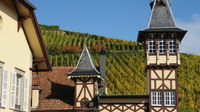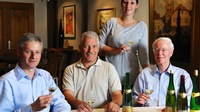|
|
 |
|
December 28, 2015
Trimbach continues to turn out stunningly tasteful, beautiful wines year after year (and indeed, generation after generation, and century after century...since 1626). With production based on vineyard holdings of a  little more than 100 acres (more than 30% of which hold Grand Cru status), this house has never seemed to slip since at least the 1970s. little more than 100 acres (more than 30% of which hold Grand Cru status), this house has never seemed to slip since at least the 1970s.
I’m not old enough to vouch for wines older than that (though I've tasted multiple wines from the '70s on site in Ribeauville), but let’s just acknowledge that 45 years of unbroken excellence seems to indicate a trend. Aside from a rather distractingly sweet Pinot Gris, the wines are all impeccably dry and marked by edgy acidity and prominent minerality.
Riesling is definitely the ticket for Trimbach, and at the single most electrifying tasting I participated in during 2015 (at TexSom in the Dallas area in August),  Jean Trimbach showed a retrospective lineup of Riesling Cuvée Frédéric Emile and Riesling Clos Ste. Hune that brought down the house (and the house was filled with 200+ wine trade professionals--who might be a bit jaded on other occasions, but were borderline worshipful in the presence of these wines). Jean Trimbach showed a retrospective lineup of Riesling Cuvée Frédéric Emile and Riesling Clos Ste. Hune that brought down the house (and the house was filled with 200+ wine trade professionals--who might be a bit jaded on other occasions, but were borderline worshipful in the presence of these wines).
Particular highlights:
Riesling Cuvée Frédéric Emile 2009 (95 points), 2005 (94), 2002 (95), 1998 (96), 1989 (96) and 1983 (95)
Riesling Clos Ste. Hune 2009 (96), 2008 (97) 1990 (98), 1985 (99), 1976 (95!)
Riesling Clos Ste. Hune Vendanges Tardives Hors Choix 1989 (98).
That these wines could be flown from France to Texas and perform like this is astonishing. That Jean Trimbach could report that 2014 might be the best vintage for Riesling ever in Alsace makes my mouth water…four months later.
Congratulations to Jean Trimbach and his family...exemplars to everyone who works with white varieties anywhere in the world.
Posted by Michael Franz at 6:21 PM
|
|
December 2, 2015
As serious party animals come down the home stretch, driving for the holidays' finish line (New Year's Eve), one beverage clearly rises to the top of the shopping list: bubbly.
Many, if not most, would simply say Champagne, but there's the rub. Too many revelers either don't or are unable to make the distinction between Champagne and other wines that fizz. Yes, all Champagnes have fizz, but not all wines that fizz are Champagne, no matter how much we wish it were so.
The first thing a holiday wine shopper needs to know is that Champagne, the real deal, is more expensive. That's the first clue, but hardly the one that matters most.
Champagne is the king of sparkling wines because it is the best wine that can be made from grapes grown in its geographical region. The finest (and most expensive) Champagnes use a high percentage of grapes grown in grand cru vineyards, which is the top designation in the Champagne district.
By comparison, it would be a safe bet that no grand cru grapes in Burgundy find their way into Cremant de Bourgogne, the bubbly wine of France's Burgundy region. What's more, the chalky soils of the Champagne region produce sparkling wines with a stony minerality and steely structure that has not been replicated anywhere else in the world that produces sparkling wine.
All of that said, it isn't necessary to spend a fortune to drink good bubbly through the holidays. Champagne is wonderful if you can afford it; otherwise there are many excellent alternatives.
Here are but a few:
Prosecco, from northern Italy's Veneto region, is a pleasing alternative, although the vast majority of prosecco is fairly simple and fruity. The most interesting and complex Prosecco comes from the Valdobbiadene district and one of the best of those is Bisol. As a good standard prosecco La Marca works for me.
Cava is the sparkling wine of Spain, produced primarily in the northeast corner near Barcelona. Most of the top cava that could compete with Champagne's complexity and structure never makes it to these shores. One of the finest cavas that is commercially available and well-priced at about $20 is Segura Viudas Reserva.
California sparkling wines come close to Champagne's complexity but generally lack the structure to age for decades as good Champagne will. There are exceptions, such as the Gloria Ferrer Royal Cuvee, and many of the top cuvees from Schramsberg.
The bottom line: No matter your budget, there are tasty bubblies in your price range.
Just know that a $14 bottle of "Champagne" might taste very good, but it's not likely the real thing.
Posted by Robert Whitley at 5:18 PM
|
|
 |
|